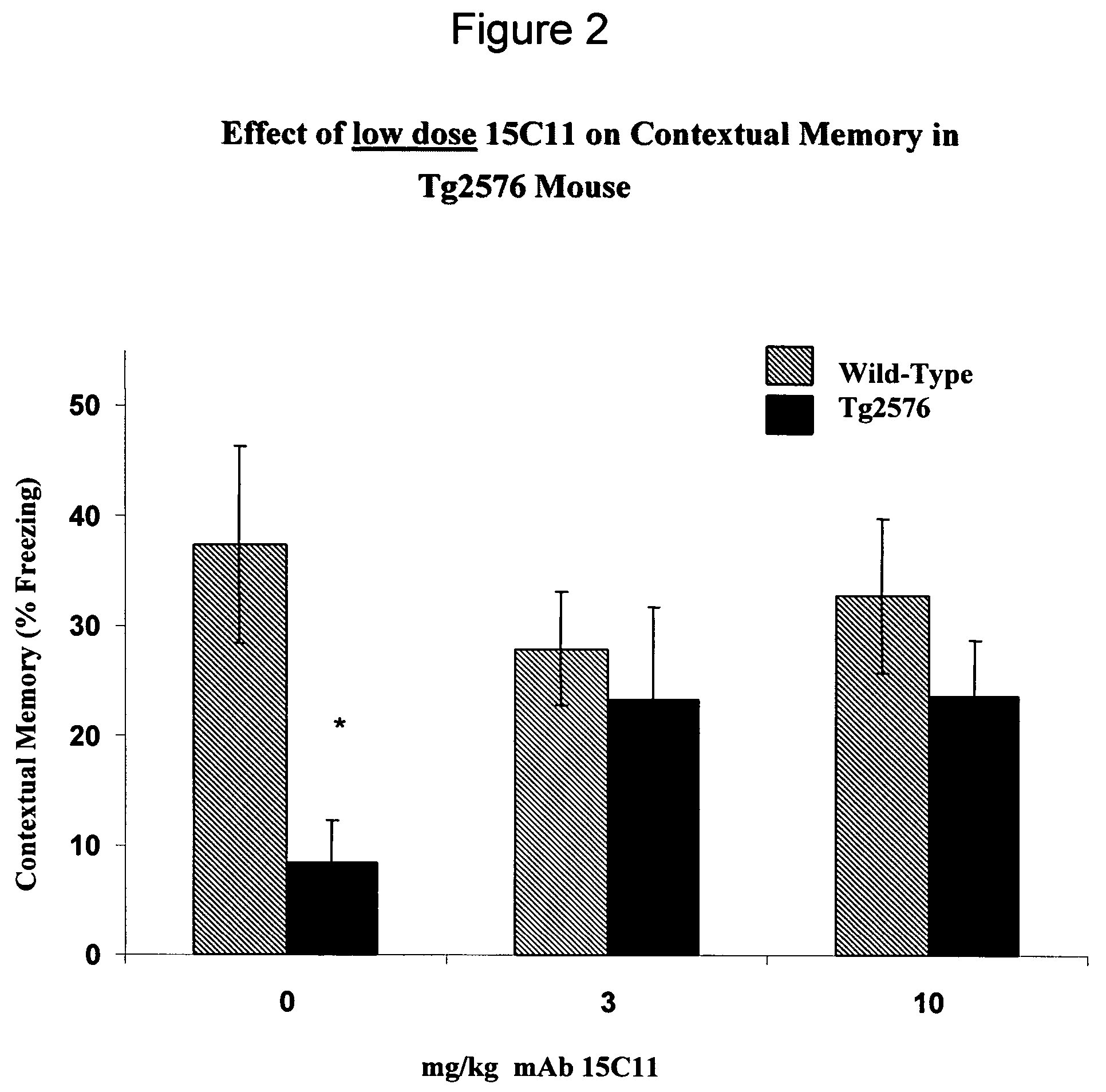Humanized antibodies that recognize beta amyloid peptide
a technology humanized antibodies, which is applied in the field of humanized antibodies that recognize beta amyloid peptide, can solve problems such as neuronal cell death, and achieve the effect of reducing the burden of beta amyloid peptide (a)
- Summary
- Abstract
- Description
- Claims
- Application Information
AI Technical Summary
Benefits of technology
Problems solved by technology
Method used
Image
Examples
examples
[0461]The following Sequence identifiers are used throughout the Examples section to refer to immunoglobulin chain variable region nucleotide and amino acid sequences.
[0462]
VLnucleotideVL amino acidVH nucleotideVH amino acidAntibodysequencesequencesequencesequence15C11SEQ IDSEQ ID NO: 2SEQ ID NO: 3SEQ ID NO: 4NO: 1(coding)(coding)9G8SEQ ID NO: 8SEQ ID NO: 5266SEQ ID NO: 9SEQ ID NO: 6
[0463]As used throughout the specification, an antibody or immunoglobulin sequence comprising a VL and / or VH sequence as set forth in any one of SEQ ID NOs: 1-9 can comprise (or encode) either the full sequence or can comprise the mature sequence (i.e., mature peptide without the signal or leader peptide).
example i
In Vivo Efficacy of Mouse 15C11 Antibody
[0464]Mouse Antibody 15C11 Improves Cognition In Vivo.
[0465]To determine the in vivo efficacy of 15C11, antibodies (including 15C11) were administered to wild type and Tg2576 mice at 3 mg / kg, 10 mg / kg, and 30 mg / kg. Mice were assayed for contextual fear conditioning as described herein.
[0466]Tg2576 mice which were administered 30 mg / kg of 15C11 displayed full and significant memory deficit reversal (see FIG. 1). Furthermore, a trend towards no impairment was found in animals receiving 3 mg / kg and 10 / mg / kg (see FIG. 2) (p value=0.1246 at 3 mg / kg of 15C11; 0.1156 at 10 mg / kg of 15C11; 0.0274 at 30 mg / kg of 15C11).
[0467]Mice displaying memory deficit reversal did so within a short time period. Without being bound by the following, this rapid improvement in cognition in mice administered 15C11 suggest a mechanism of action of 15C11 that involves the capture of soluble Aβ in the blood and the subsequent removal of Aβ from the CNS into the plasma.
example ii
Capture Ability of Mouse 15C11
[0468]The ability of various antibodies (including 15C11) to capture soluble Aβ was assayed as follows. Various concentrations of antibody (up to 10 μg / ml) were incubated with 50,000 CPM of 125I-Aβ 1-42 (or 125I-Aβ 1-40). The concentration of antibody sufficient to bind 25% of the radioactive counts was determined in a capture radioimmunoassay. Certain antibodies did not bind 25% of the counts at the highest concentration tested (i.e., 10 μg / ml). For such antibodies, the percentage of counts bound at 10 μg / ml was determined. At 3 μg / ml, 15C11 bound 25% of the radioactive counts (i.e., 125I-Aβ). This capture was significant as compared to other monoclonal antibodies raised against central Aβ fragments (e.g., Aβ 13-28 or Aβ 17-28). The range of concentrations necessary to capture 25% of the labeled Aβ for such antibodies is from about 0.1 μg / ml to 10 μg / ml with some antibodies capturing less than 25% labeled Aβ (e.g., 10-20%) when assayed at 10 μg / ml.
[046...
PUM
| Property | Measurement | Unit |
|---|---|---|
| time | aaaaa | aaaaa |
| time | aaaaa | aaaaa |
| time | aaaaa | aaaaa |
Abstract
Description
Claims
Application Information
 Login to View More
Login to View More - R&D
- Intellectual Property
- Life Sciences
- Materials
- Tech Scout
- Unparalleled Data Quality
- Higher Quality Content
- 60% Fewer Hallucinations
Browse by: Latest US Patents, China's latest patents, Technical Efficacy Thesaurus, Application Domain, Technology Topic, Popular Technical Reports.
© 2025 PatSnap. All rights reserved.Legal|Privacy policy|Modern Slavery Act Transparency Statement|Sitemap|About US| Contact US: help@patsnap.com



